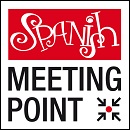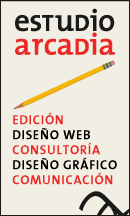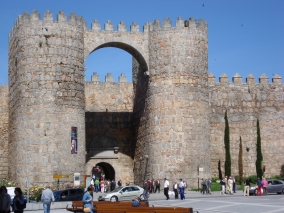Spanish schools and accommodation to study Spanish in Spain
Recent posts
Last schools
introduced
introduced
0 Accommodation

1 Spanish schools

Learning Spanish in Avila. The tourist guide to study your Spanish course.
Choose Avila is you are willing to study Spanish in a historical background. Its castle and historical centre reminds you of the middle ages when monks were only literate in charge of preserving old Spanish and Latin books, by copying them day and night.
General Information. 57,000 inhabitants. 115 kilometres to the west of Madrid. Avila belongs to the Autonomous Community of Castile and León. Avila is famous for being surrounded by an unbroken medieval wall, built in a Romanesque style. It is also one of the Spanish cities with the highest number of Romanesque and Gothic churches. Avila is situated on a hill on the right bank of the Adaja River, a tributary of the Duero River. Avila has three schools which form part of the University of Salamanca: the Escuela Politécnica Superior de Ávila, where you can study technical degrees; the Escuela Universitaria de Educación y Turismo de Avila, which teaches education and tourism; the Escuela Universitaria de Enfermería, which specialises in nursing. It also has the Universidad Católica de Ávila, a private Catholic university that offers such degree subjects as business studies, law or forest engineering. Avila is a very attractive place to study Spanish with some language schools offering a wide range of courses.
Surrounding Areas. Segovia (86 kilometres), the Monastery of El Escorial (75 kilometres), the ‘Valley of the Fallen' (Valle de los Caídos) (46 kilometres), and a little further away, Salamanca (100 kilometres) and Madrid (113 kilometres).
World Heritage Site. Avila was awarded Historical-Artistic Grouping Status in 1984 and its old quarter was declared a UNESCO World Heritage Site in 1985.
Main Sights. The Cathedral, built between the 12th and 15th centuries, which acted as a military fort thanks to the shape of its façade. St. Vincent's Basilica (Basílica de San Vicente). The palace of Don Diego de Ávila, which dates back to the 15th century. And a final mention for the attractive City Wall, which began to be built in 1090 and protects a total area covering 31 hectares. The monuments are a major attraction for the many students who decide to study Spanish in Avila.
Culture. At the beginning of July, there is an International Festival of Street Theatre and Circus Arts (Festival Internacional de Teatro de Calle y Artes Circenses). Among the many museums that you can visit in Avila are: Museo de la Encarnación; Museo de Santo Tomás; Museo de Arte Oriental. The theatres include: Teatro Cine Castilla and Teatro Avenida. In the first weekend of September, there is a medieval market that takes place in the main streets of the old quarter and many of the locals dress in traditional costume; there are also groups of strolling musicians playing popular songs (pasacalles) and shows throughout the day.
Shopping. The main shopping area can be found in Calle Mayor in the city centre. If you prefer shopping centres, then you should try the following: Centro Comercial el Bulevar, which boasts almost 100 shops and a Carrefour hypermarket and is within easy reach of the city; Galerías San Roque, located in Paseo de San Roque; Centro Comercial Multitienda in Calle Eduardo Marquina; Centro Comercial Maceros.
Gastronomy. If you fancy going out for tapas (accompanying your drinks with small snacks while moving from bar to bar), we suggest any of the many establishments to be found in the centre and within the city wall. The typical dishes include judías del barco (white Barco beans with chorizo in a thick sauce), chuletón de Ávila (large T-bone steak), patatas revolconas (mashed potatoes dressed with paprika and bacon bits) and for dessert, candied egg yolks (yemas de Santa Teresa).
Sports. There is a sports complex called the Ciudad Deportiva with both indoor heated and open-air swimming pools, tennis and paddle tennis courts, an athletics track, a football field and a basketball court, so you can play or learn any of these sports there. The Club Casino Abulense, which is made up of a head office and a country club with tennis courts, a swimming pool and running tracks... Naturavila, an area where you can play golf or tennis, go for walks or go horse-riding along special trails. There are two other sports centres: San Antonio and Carlos Sastre.
Fiestas. The fiestas of St. Teresa (during October) open with popular inaugural speeches (pregones) from both the Mayor and a celebrity guest. During the festivities there are several concerts, a funfair, bullfights, pasacalles, parades, and hot chocolate with deep-fried dough strips (chocolatadas con churros)... Another important fiesta in Avila is San Segundo, which is held on 2nd May.
Transport. Avila has a tourist train that leaves from the Plaza de San Vicente and has 24 stops in all of the city's main sights. It is easy to get from Avila to other Spanish cities by train or by using the various coach services.
Nightlife. Students who decide to study Spanish in Avila will discover a very active nightlife. The best place to party at night is Calle Vallespín, as here you will find a variety of pubs and different late-night vibes all in the same area.
General Information. 57,000 inhabitants. 115 kilometres to the west of Madrid. Avila belongs to the Autonomous Community of Castile and León. Avila is famous for being surrounded by an unbroken medieval wall, built in a Romanesque style. It is also one of the Spanish cities with the highest number of Romanesque and Gothic churches. Avila is situated on a hill on the right bank of the Adaja River, a tributary of the Duero River. Avila has three schools which form part of the University of Salamanca: the Escuela Politécnica Superior de Ávila, where you can study technical degrees; the Escuela Universitaria de Educación y Turismo de Avila, which teaches education and tourism; the Escuela Universitaria de Enfermería, which specialises in nursing. It also has the Universidad Católica de Ávila, a private Catholic university that offers such degree subjects as business studies, law or forest engineering. Avila is a very attractive place to study Spanish with some language schools offering a wide range of courses.
Surrounding Areas. Segovia (86 kilometres), the Monastery of El Escorial (75 kilometres), the ‘Valley of the Fallen' (Valle de los Caídos) (46 kilometres), and a little further away, Salamanca (100 kilometres) and Madrid (113 kilometres).
World Heritage Site. Avila was awarded Historical-Artistic Grouping Status in 1984 and its old quarter was declared a UNESCO World Heritage Site in 1985.
Main Sights. The Cathedral, built between the 12th and 15th centuries, which acted as a military fort thanks to the shape of its façade. St. Vincent's Basilica (Basílica de San Vicente). The palace of Don Diego de Ávila, which dates back to the 15th century. And a final mention for the attractive City Wall, which began to be built in 1090 and protects a total area covering 31 hectares. The monuments are a major attraction for the many students who decide to study Spanish in Avila.
Culture. At the beginning of July, there is an International Festival of Street Theatre and Circus Arts (Festival Internacional de Teatro de Calle y Artes Circenses). Among the many museums that you can visit in Avila are: Museo de la Encarnación; Museo de Santo Tomás; Museo de Arte Oriental. The theatres include: Teatro Cine Castilla and Teatro Avenida. In the first weekend of September, there is a medieval market that takes place in the main streets of the old quarter and many of the locals dress in traditional costume; there are also groups of strolling musicians playing popular songs (pasacalles) and shows throughout the day.
Shopping. The main shopping area can be found in Calle Mayor in the city centre. If you prefer shopping centres, then you should try the following: Centro Comercial el Bulevar, which boasts almost 100 shops and a Carrefour hypermarket and is within easy reach of the city; Galerías San Roque, located in Paseo de San Roque; Centro Comercial Multitienda in Calle Eduardo Marquina; Centro Comercial Maceros.
Gastronomy. If you fancy going out for tapas (accompanying your drinks with small snacks while moving from bar to bar), we suggest any of the many establishments to be found in the centre and within the city wall. The typical dishes include judías del barco (white Barco beans with chorizo in a thick sauce), chuletón de Ávila (large T-bone steak), patatas revolconas (mashed potatoes dressed with paprika and bacon bits) and for dessert, candied egg yolks (yemas de Santa Teresa).
Sports. There is a sports complex called the Ciudad Deportiva with both indoor heated and open-air swimming pools, tennis and paddle tennis courts, an athletics track, a football field and a basketball court, so you can play or learn any of these sports there. The Club Casino Abulense, which is made up of a head office and a country club with tennis courts, a swimming pool and running tracks... Naturavila, an area where you can play golf or tennis, go for walks or go horse-riding along special trails. There are two other sports centres: San Antonio and Carlos Sastre.
Fiestas. The fiestas of St. Teresa (during October) open with popular inaugural speeches (pregones) from both the Mayor and a celebrity guest. During the festivities there are several concerts, a funfair, bullfights, pasacalles, parades, and hot chocolate with deep-fried dough strips (chocolatadas con churros)... Another important fiesta in Avila is San Segundo, which is held on 2nd May.
Transport. Avila has a tourist train that leaves from the Plaza de San Vicente and has 24 stops in all of the city's main sights. It is easy to get from Avila to other Spanish cities by train or by using the various coach services.
Nightlife. Students who decide to study Spanish in Avila will discover a very active nightlife. The best place to party at night is Calle Vallespín, as here you will find a variety of pubs and different late-night vibes all in the same area.
© TEXT: SPANISH IN TOUR.
























